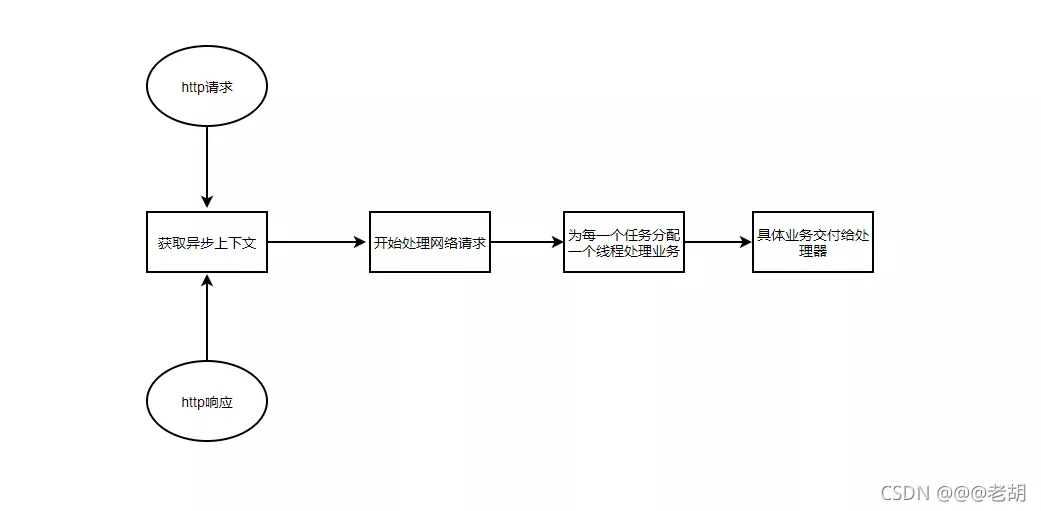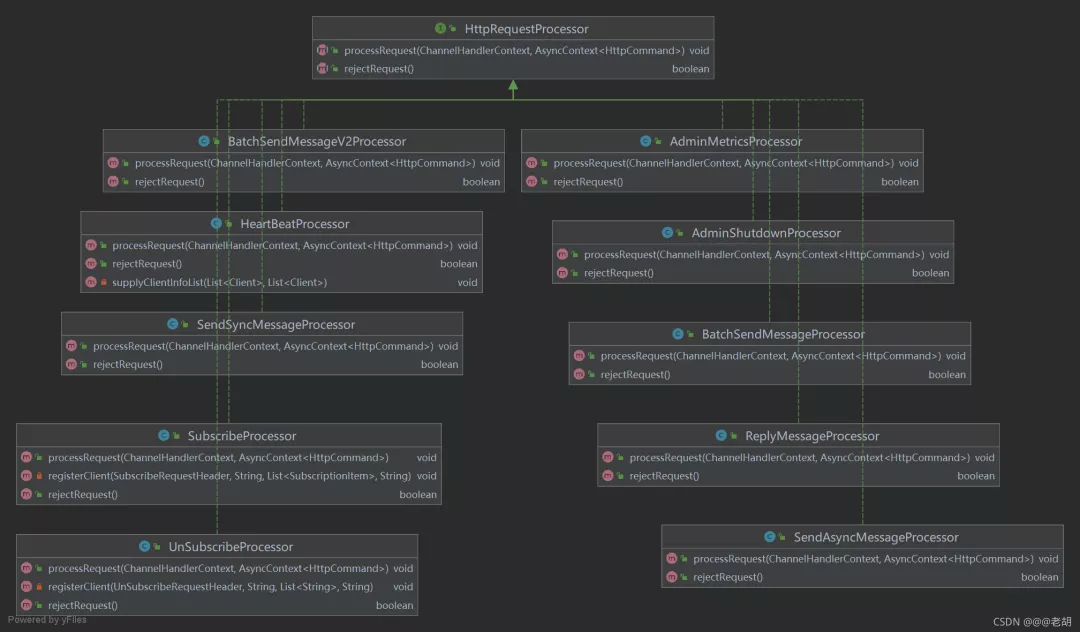

EventMesh源码手撕系列(二)之HTTP处理器
source link: https://my.oschina.net/webank/blog/5310226
Go to the source link to view the article. You can view the picture content, updated content and better typesetting reading experience. If the link is broken, please click the button below to view the snapshot at that time.
EventMesh源码手撕系列(二)之HTTP处理器 - 微众开源的个人空间 - OSCHINA - 中文开源技术交流社区
上一篇Http Server实现中讲到,当channel被注册之后,这个类中的initChannel方法就会被调用,同时在管道后面加入handlers。那具体的,我们的Http Server是怎样处理消息的?
【源代码片段】
class HttpsServerInitializer extends ChannelInitializer<SocketChannel> {...// 在管道后面加入handlerspipeline.addLast(new HttpRequestDecoder(),// 这个是对http解码new HttpResponseEncoder(),// 这个是对http的响应编码new HttpConnectionHandler(),// 这个是对http连接处理new HttpObjectAggregator(Integer.MAX_VALUE),// 这个是http对象聚合new HTTPHandler());// 这个是http的Handler的具体实现}}}
处理逻辑

【源代码片段】
class HTTPHandler extends SimpleChannelInboundHandler<HttpRequest> {@Overrideprotected void channelRead0(ChannelHandlerContext ctx, HttpRequest httpRequest) throws Exception {HttpPostRequestDecoder decoder = null;// todo start server span, we should get channel here to put span in channel's context in async call.try {if (!httpRequest.decoderResult().isSuccess()) {sendError(ctx, HttpResponseStatus.BAD_REQUEST);return;}// 请求命令final HttpCommand requestCommand = new HttpCommand();// todo record command opaque in span.httpRequest.headers().set(ProtocolKey.ClientInstanceKey.IP, RemotingHelper.parseChannelRemoteAddr(ctx.channel()));...Map<String, Object> bodyMap = new HashMap<>();// GET请求if (httpRequest.method() == HttpMethod.GET) {QueryStringDecoder getDecoder = new QueryStringDecoder(httpRequest.uri());getDecoder.parameters().entrySet().forEach(entry -> {bodyMap.put(entry.getKey(), entry.getValue().get(0));});// POST请求} else if (httpRequest.method() == HttpMethod.POST) {decoder = new HttpPostRequestDecoder(defaultHttpDataFactory, httpRequest);// 获取参数列表List<InterfaceHttpData> parmList = decoder.getBodyHttpDatas();for (InterfaceHttpData parm : parmList) {if (parm.getHttpDataType() == InterfaceHttpData.HttpDataType.Attribute) {Attribute data = (Attribute) parm;bodyMap.put(data.getName(), data.getValue());}}} else {sendError(ctx, HttpResponseStatus.METHOD_NOT_ALLOWED);return;}...String requestCode =(httpRequest.method() == HttpMethod.POST) ? StringUtils.deleteWhitespace(httpRequest.headers().get(ProtocolKey.REQUEST_CODE)): MapUtils.getString(bodyMap, StringUtils.lowerCase(ProtocolKey.REQUEST_CODE), "");requestCommand.setHttpMethod(httpRequest.method().name());requestCommand.setHttpVersion(httpRequest.protocolVersion().protocolName());requestCommand.setRequestCode(requestCode);// todo record command method, version and requestCode in span.// 响应命令HttpCommand responseCommand = null;...try {// requestCommand头部和主体requestCommand.setHeader(Header.buildHeader(requestCode, parseHTTPHeader(httpRequest)));requestCommand.setBody(Body.buildBody(requestCode, bodyMap));} catch (Exception e) {responseCommand = requestCommand.createHttpCommandResponse(EventMeshRetCode.EVENTMESH_RUNTIME_ERR.getRetCode(), EventMeshRetCode.EVENTMESH_RUNTIME_ERR.getErrMsg() + EventMeshUtil.stackTrace(e, 3));sendResponse(ctx, responseCommand.httpResponse());return;}...// 异步消息上下文AsyncContext<HttpCommand> asyncContext = new AsyncContext<HttpCommand>(requestCommand, responseCommand, asyncContextCompleteHandler);// 处理网络请求processEventMeshRequest(ctx, asyncContext);} catch (Exception ex) {httpServerLogger.error("AbrstractHTTPServer.HTTPHandler.channelRead0 err", ex);// todo span end with exception.} finally {try {decoder.destroy();} catch (Exception e) {}}}// 处理网络请求public void processEventMeshRequest(final ChannelHandlerContext ctx,final AsyncContext<HttpCommand> asyncContext) {final Pair<HttpRequestProcessor, ThreadPoolExecutor> choosed = processorTable.get(Integer.valueOf(asyncContext.getRequest().getRequestCode()));try {// 为任务分配一个线程choosed.getObject2().submit(() -> {try {// 拒绝请求if (choosed.getObject1().rejectRequest()) {HttpCommand responseCommand = asyncContext.getRequest().createHttpCommandResponse(EventMeshRetCode.EVENTMESH_REJECT_BY_PROCESSOR_ERROR.getRetCode(), EventMeshRetCode.EVENTMESH_REJECT_BY_PROCESSOR_ERROR.getErrMsg());asyncContext.onComplete(responseCommand);if (asyncContext.isComplete()) {if (httpLogger.isDebugEnabled()) {httpLogger.debug("{}", asyncContext.getResponse());}sendResponse(ctx, responseCommand.httpResponse());}return;}// 处理请求,对接到http的协议部分的处理器choosed.getObject1().processRequest(ctx, asyncContext);if (asyncContext == null || !asyncContext.isComplete()) {return;}...// 发送响应sendResponse(ctx, asyncContext.getResponse().httpResponse());} catch (Exception e) {httpServerLogger.error("process error", e);}});} catch (RejectedExecutionException re) {...try {sendResponse(ctx, asyncContext.getResponse().httpResponse());} catch (Exception e) {}}}...}
处理器
每一个处理器都会继承它的父类HttpRequestProcessor,并且重写处理请求和拒绝请求两个方法。具体业务中,会根据消息的请求码分配处理器来对消息进行处理。

处理器逻辑,这里以SendAsyncMessageProcessor消息处理为例进行讲解,其他处理器参照即可。

public class SendAsyncMessageProcessor implements HttpRequestProcessor {@Overridepublic void processRequest(ChannelHandlerContext ctx, AsyncContext<HttpCommand> asyncContext) throws Exception {...// 获取发送消息的请求SendMessageRequestHeader sendMessageRequestHeader = (SendMessageRequestHeader) asyncContext.getRequest().getHeader();SendMessageRequestBody sendMessageRequestBody = (SendMessageRequestBody) asyncContext.getRequest().getBody();// 获取发送消息的响应SendMessageResponseHeader sendMessageResponseHeader =SendMessageResponseHeader.buildHeader(Integer.valueOf(asyncContext.getRequest().getRequestCode()), eventMeshHTTPServer.getEventMeshHttpConfiguration().eventMeshCluster,IPUtil.getLocalAddress(), eventMeshHTTPServer.getEventMeshHttpConfiguration().eventMeshEnv,eventMeshHTTPServer.getEventMeshHttpConfiguration().eventMeshIDC);//证实请求头部if (StringUtils.isBlank(sendMessageRequestHeader.getIdc())|| StringUtils.isBlank(sendMessageRequestHeader.getPid())|| !StringUtils.isNumeric(sendMessageRequestHeader.getPid())|| StringUtils.isBlank(sendMessageRequestHeader.getSys())) {responseEventMeshCommand = asyncContext.getRequest().createHttpCommandResponse(sendMessageResponseHeader,SendMessageResponseBody.buildBody(EventMeshRetCode.EVENTMESH_PROTOCOL_HEADER_ERR.getRetCode(), EventMeshRetCode.EVENTMESH_PROTOCOL_HEADER_ERR.getErrMsg()));asyncContext.onComplete(responseEventMeshCommand);return;}//证实请求主体if (StringUtils.isBlank(sendMessageRequestBody.getBizSeqNo())|| StringUtils.isBlank(sendMessageRequestBody.getUniqueId())|| StringUtils.isBlank(sendMessageRequestBody.getProducerGroup())|| StringUtils.isBlank(sendMessageRequestBody.getTopic())|| StringUtils.isBlank(sendMessageRequestBody.getContent())|| (StringUtils.isBlank(sendMessageRequestBody.getTtl()))) {//sync message TTL can't be emptyresponseEventMeshCommand = asyncContext.getRequest().createHttpCommandResponse(sendMessageResponseHeader,SendMessageResponseBody.buildBody(EventMeshRetCode.EVENTMESH_PROTOCOL_BODY_ERR.getRetCode(), EventMeshRetCode.EVENTMESH_PROTOCOL_BODY_ERR.getErrMsg()));asyncContext.onComplete(responseEventMeshCommand);return;}//检查aclif(eventMeshHTTPServer.getEventMeshHttpConfiguration().eventMeshServerSecurityEnable) {String remoteAddr = RemotingHelper.parseChannelRemoteAddr(ctx.channel());String user = sendMessageRequestHeader.getUsername();String pass = sendMessageRequestHeader.getPasswd();String subsystem = sendMessageRequestHeader.getSys();int requestCode = Integer.valueOf(sendMessageRequestHeader.getCode());String topic = sendMessageRequestBody.getTopic();try {Acl.doAclCheckInHttpSend(remoteAddr, user, pass, subsystem, topic, requestCode);}catch (Exception e){//String errorMsg = String.format("CLIENT HAS NO PERMISSION,send failed, topic:%s, subsys:%s, realIp:%s", topic, subsys, realIp);...}}// 分配生产者组String producerGroup = sendMessageRequestBody.getProducerGroup();EventMeshProducer eventMeshProducer = eventMeshHTTPServer.getProducerManager().getEventMeshProducer(producerGroup);...String ttl = String.valueOf(EventMeshConstants.DEFAULT_MSG_TTL_MILLS);// 消息Message omsMsg = new Message();try {// bodyomsMsg.setBody(sendMessageRequestBody.getContent().getBytes(EventMeshConstants.DEFAULT_CHARSET));// topicomsMsg.setTopic(sendMessageRequestBody.getTopic());omsMsg.putSystemProperties(Constants.PROPERTY_MESSAGE_DESTINATION, sendMessageRequestBody.getTopic());...}// ttlomsMsg.putUserProperties(Constants.PROPERTY_MESSAGE_TIMEOUT, ttl);// bizNoomsMsg.putSystemProperties(Constants.PROPERTY_MESSAGE_SEARCH_KEYS, sendMessageRequestBody.getBizSeqNo());omsMsg.putUserProperties("msgType", "persistent");omsMsg.putUserProperties(EventMeshConstants.REQ_C2EVENTMESH_TIMESTAMP, String.valueOf(System.currentTimeMillis()));omsMsg.putUserProperties(Constants.RMB_UNIQ_ID, sendMessageRequestBody.getUniqueId());omsMsg.putUserProperties(EventMeshConstants.REQ_EVENTMESH2MQ_TIMESTAMP, String.valueOf(System.currentTimeMillis()));// new rocketmq client can't support put DeFiBusConstant.PROPERTY_MESSAGE_TTL// rocketMQMsg.putUserProperty(DeFiBusConstant.PROPERTY_MESSAGE_TTL, ttl);} catch (Exception e) {...asyncContext.onComplete(responseEventMeshCommand);return;}// 发送消息的上下文final SendMessageContext sendMessageContext = new SendMessageContext(sendMessageRequestBody.getBizSeqNo(), omsMsg, eventMeshProducer, eventMeshHTTPServer);eventMeshHTTPServer.metrics.summaryMetrics.recordSendMsg();final CompleteHandler<HttpCommand> handler = new CompleteHandler<HttpCommand>() {@Override// 响应public void onResponse(HttpCommand httpCommand) {try {if (httpLogger.isDebugEnabled()) {httpLogger.debug("{}", httpCommand);}eventMeshHTTPServer.sendResponse(ctx, httpCommand.httpResponse());eventMeshHTTPServer.metrics.summaryMetrics.recordHTTPReqResTimeCost(System.currentTimeMillis() - asyncContext.getRequest().getReqTime());} catch (Exception ex) {}}};try {sendMessageContext.getMsg().getUserProperties().put(EventMeshConstants.REQ_EVENTMESH2MQ_TIMESTAMP, String.valueOf(System.currentTimeMillis()));// 生产组发送精简消息eventMeshProducer.send(sendMessageContext, new SendCallback() {// 成功@Overridepublic void onSuccess(SendResult sendResult) {...}// 错误@Overridepublic void onException(OnExceptionContext context) {...}});} catch (Exception ex) {...}return;}@Overridepublic boolean rejectRequest() {return false;}}
最后,我推荐大家去看看官方的协议文档中关于协议这一部分的内容,可以方便我们理解:官方http协议文档
注:本文内容由社区小伙伴陈创慧提供,
Recommend
About Joyk
Aggregate valuable and interesting links.
Joyk means Joy of geeK